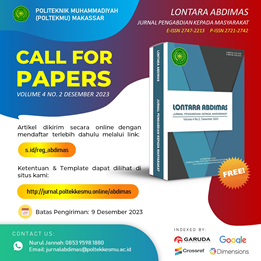Peningkatan Pengetahuan Masyarakat Desa Kaloling Kec. Gatarangkeke Kab. Bantaeng Terhadap Bahaya Residu Pestisida Bagi Kesehatan
Abstract
Abstract
The attack of plant pests (OPT) that almost occur in every planting season encourages farmers to use synthetic pesticides in crop pest control measures. Pesticide residues in the environment are a bad result of using or direct application by spraying. The Kaloling Village farming community has never received counseling about occupational safety and health, especially to farmers related to the use of pesticides. The output target of the implementation of this community service activity is to increase community knowledge in Kaloling Village, Gantarang Keke Subdistrict, Bantaeng Regency, about the dangers of pesticide residues for health. The method of implementation includes surveys and permits as well as the preparation of facilities and infrastructure, exposure to counseling material about the dangers of synthetic pesticide residues, while also conducting a discussion phase between the community members and providing feedback as an evaluation. Based on the results of counseling shows that the lack of knowledge and understanding, as well as the awareness of farmers in the use of pesticides by not following instructions on the pack, not using personal protective equipment (PPE) and not paying attention to the direction of the wind are risk factors to accelerate pesticide exposure in farmers' bodies. The effects of pesticide poisoning can cause symptoms of vomiting, diarrhea, dyspnea, blurred vision, paresthesia, chest pain. The final activity of the extension was carried out an evaluation to the farmers as extension participants about the level of understanding of the extension material, with the hope that this activity could increase farmers' knowledge.
References
Amalia, E., Joy, B., Sunardi, 2016, Residu Pestisida pada Tanaman Hortikultura (Studi Kasus di Desa Cihanjuang Rahayu Kecamatan Parongpong Kabupaten Bandung Barat), Jurnal Agrikultura, 27 (1): 23-29.
Astawan M. 2009. Kandungan Gizi Aneka Bahan Makanan. Jurusan Teknologi Pangan dan Gizi IPB.
Atmawidjaja, S, DH Tjahjono, dan Rudianto. 2004. Pengaruh Perlakuan Terhadap Kadar Residu Pestisida Metidation Pada Tomat. Acta Pharmaceutica Indonesia. 29(2): 72-82.
Cahyono, A. B. 2010. Keselamatan Kerja Bahan Kimia di Industri. Yogyakarta: Gadhjah Mada University Press.
Djojosumarto, P., 2008. Teknik Aplikasi Pestisida Pertanian. Penerbit Kanisius. Yogyakarta.
Direktorat Jendral Prasarana dan Sarana Direktorat Pupuk dan Pestisida Kementerian Pertanian 2012, Pedoman Teknik Kajian Pestisida Terdaftar Beredar. Jakarta
Kim, J. Hyun, Kim Jaeyoung, Cha E. Stil, Ko Yousun, Kim D. Hwan, Lee W. Jee, 2013. Work- Related Risk Factors by Severity for Acute Pesticide Poisoning Among Male Farmers in South Korea. International Journal of Environmental Research and Public Health, 1100-1112.
Koleva, N.G., Schneider, U.A., 2009. The Impact Of Climate Change On The External Cost Of Pesticide Applications in US agriculture. International Journal of Agricultural Sustainability, 7(3): 203-216.
Laba, I. W., 2010. Analisis Empiris Penggunaan Insektisida Menuju Pertanian Berkelanjutan. Naskah disarikan dari bahan Orasi Profesor Riset di Bogor, Pengembangan Inovasi Pertanian. 3 (2): pp 120-137.
Ohorella, A. 2011. Identifikasi Residu Pestisida Golongan Organoklorin bahan aktif Lindan pada Wortel di Pasar Tradisional (Pasar terong) dan Pasar Modern (Swalayan Ramayana M‟tos Supermaket) Kota Makassar. Fakultas Kesehatan Masyarakat:UNHAS Makassar.
Phuspa, S. M., dan Rosanti, E., 2017. Penyuluhan Mengenai Penggunaan Pestisida yang Baik dan Benar di Desa Jurug Kecamatan Sooko Kabupaten Ponorogo. International Journal of Community Service Learning, 1 (2): 95-100.
Purnama, A, I. 2013. Identifikasi Residu Pestisida Pada Lindane Pada Tomat Buah Dan Tomat Biasa Dipasar Terong Dan Lotte Mart Kota Makassar. Skripsi. Fakultas Kesehatan Masyarakat: UNHAS Makassar.
Tarwaka. 2012. Keselamatan dan Kesehatan Kerja. Edisi 2.Harapan Press. Surakarta.
Triani, I GA. L, I.BW. Gunam dan L.P. Wrasiati. 2013. Analisis Residu Insektisida Pada Kacang Panjang (Vigna Sinensis) Yang Dihasilkan Di Kabupaten Tabanan. Laporan Akhir Penelitian Hibah Bersaing, Fakultas Teknologi Pertanian, Universitas Udayana. Bukit Jimbaran, Bali.
WHO. 2006. Sound Management of Pestisicedes And Diagnosis And Treatment Of Pesticide Poisoning. National Poison Centre, Universiti Sains Malaysia.
Yusnani. 2013. Identifikasi Residu Pestisida Golongan Organofosfat pada Sayuran Kentang di Swalayan Lottemart dan Pasar Terong Kota Makassar. Balai Teknik Kesehatan Lingkungan dan Pengendalian Penyakit. Kesehatan Lingkungan Fakultas Kesehatan Masyarakat UNHAS. Makassar.
Zhou P. 2012. Dietary Exposure To Persistent Or¬ganochlorine Pesticides In 2007 Chinese Total Diet Study. Environment International, 42: 152-159.











